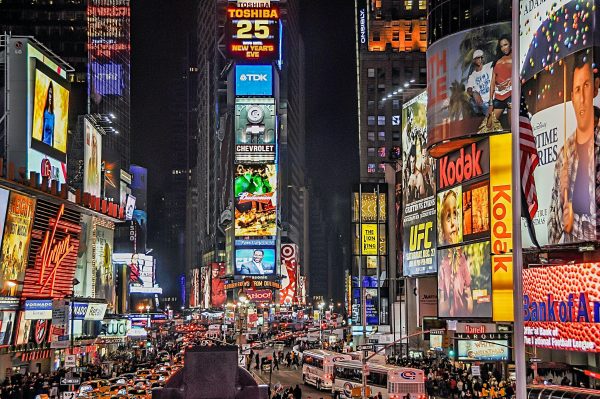A view from Marcos Angelides
 The company you keep says a lot about who you are. It’s true for people and it’s true for brands.
The company you keep says a lot about who you are. It’s true for people and it’s true for brands.
Nespresso understood this when it defined its competitor set. Rather than being seen as 10 times more expensive than instant coffee it chose to be seen as one-tenth the price of a Starbucks.
Non-dairy milks know this, too. They don’t need to be refrigerated before they’re opened, but being stocked in a supermarket chiller means they’re seen as a direct alternative to cow’s milk.
This is why it makes sense that the out-of-home industry would jump towards the term “programmatic”.
Rather than being seen as the world’s oldest channel, they can be reinvented as part of the world’s newest medium.
But repositioning comes with a downside, namely, it creates expectations. If a product can’t reflect those expectations, things get tricky.
This might explain the recent findings from JCDecaux’s VIOOH report, published last month. Uptake in programmatic OOH has been marginal over the past year, less than 5%. The authors rightly call out a need for better education.
But perhaps there’s another issue at play. Is the mantle of programmatic making education harder, by creating expectations that are difficult to meet?
I’m a big fan of programmatic OOH. I’ve worked on a number of its early incarnations and see huge opportunities for the future. However, I’ve also seen the criticisms thrown at it, and questions we still need to resolve.
Access
One of the catalysts for the birth of programmatic buying was the abundance of digital inventory. Publishers simply had too much supply, and programmatic became a vehicle for funnelling demand. The same is true for OOH. As digital units have expanded, there has been an explosion in real estate. Digital OOH now represents half of the marketplace and is seen by two-thirds of the country. As each unit rotates six digital ads per minute, versus one static ad per two weeks, the total volume of placements has skyrocketed.
But not all OOH inventory is sold on programmatic. Much like the early days of digital, the marque units are mostly sold via direct buys. This is particularly the case in Q4, where inventory can be snapped up months in advance.
This leaves programmatic as a second-tier proposition. While the inventory is still strong, it’s always a challenge when a new offering doesn’t include the flagship placements. While it’s still early days, the OOH industry will need to decide if it is entirely in when it comes to programmatic. Moving marque sites over will be a big step towards elevating the product from a supplementary offering to a primary service.
Price
The second challenge is price. As OOH moves into the programmatic space, the relative value of the channel changes. No longer are you comparing billboards with costly TV campaigns or expensive cover wraps. Sites are now bought as a cost per mille and being compared with other digital buys, most of which are a fraction of the cost.
While Nespresso changed its competitive set to make its price point more palatable (one-tenth of the price of a Starbucks coffee), programmatic OOH risks moving the other way and making the comparative costs seem incredibly expensive (10 times more than an instant coffee).
The way that programmatic OOH is traded will play a big part in how well the product is ultimately accepted. It may be wise for the OOH industry not to fly too close to the metaphorical sun of CPMs and second-price auctions. It’s simply not a battle it can win. Instead, it may need to take cues from the fashion industry, focusing on the quality of its product rather than its cost.
Ownership
The final challenge is, which marketing team is best placed to manage this new channel? Traditionally, OOH was managed by clients on the brand side, who understood the value of broadcast media and the role it plays for driving fame and salience.
As programmatic becomes a bigger part of the conversation, clients are tasking their performance leads to assess the channel. While that may seem like a positive, allowing OOH to open up new budget pots and reach more clients, it completely changes the way it’s seen. A performance director is often KPI-ed on short-term outcomes and measurable action, neither of which plays to OOH’s strengths.
While businesses recognise the need to better join brand and performance marketing, the reality is that many organisations still silo these departments, and reward them for individual efforts over integrated results. OOH needs to be careful it doesn’t fall into the middle of this issue and become a victim of disconnected goals.
In fairness, programmatic OOH could become a bridge to link these departments together but doing that will require a lot of internal collaboration as well as an experienced agency partner.
Education and experience
As the report points out, the biggest priority for programmatic OOH is education. Agencies and brands need to better understand the offering if they’re ever going to use it, which also means being clear about what it does and does not do.
But perhaps there’s another association we can take from the world of programmatic, and that’s the simple method of “test and learn”. Small campaigns build experience, which creates confidence, which leads to scale. And before we know it, everyone will understand the value of the world’s newest medium.
Marcos Angelides is chief strategy and innovation officer at Spark Foundry









